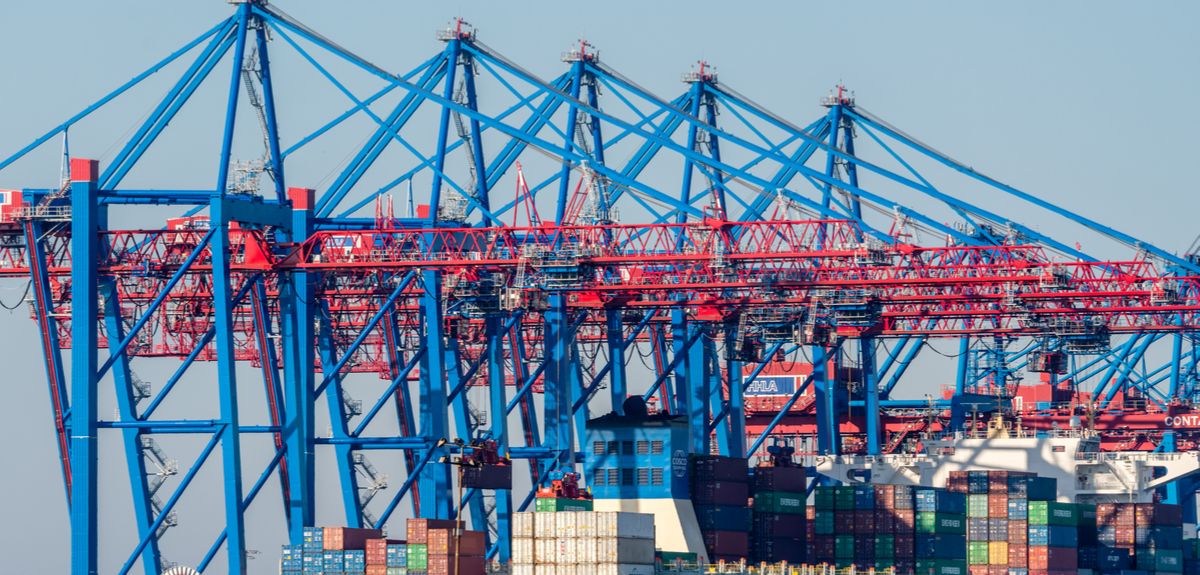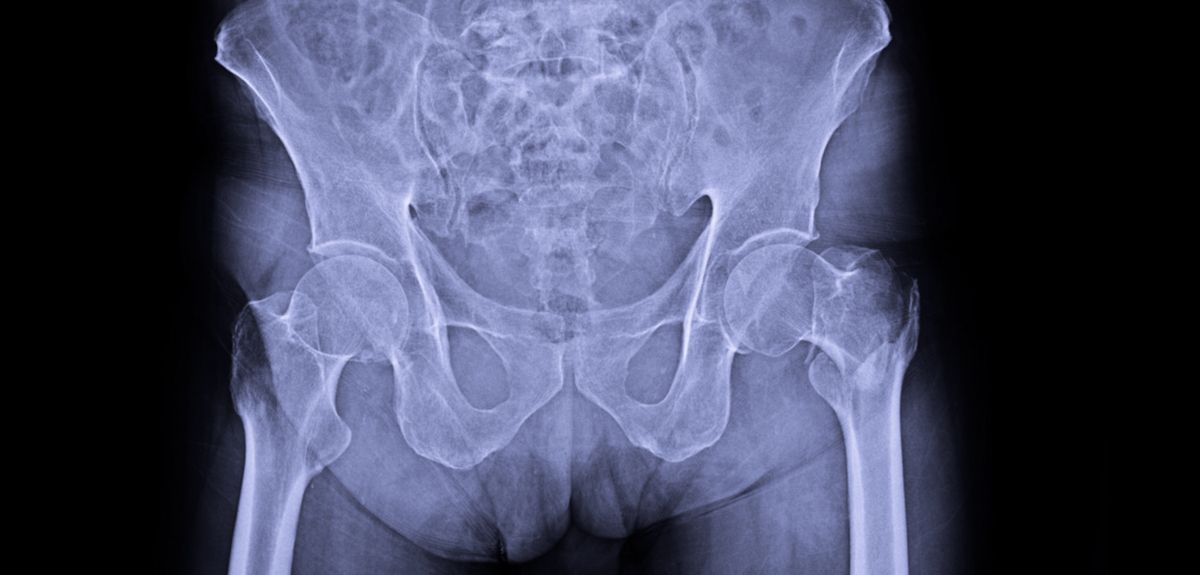Features
Professor Xiaolan Fu of the Oxford Department of International Development (ODID) explains how a proposed new approach to measuring global trade would suggest that the US trade deficit is actually about half as big as official figures report.
As the world moves towards a new trade war, with the imposition of US tariffs on goods from the EU, China, Canada and Mexico, having reliable international trade statistics is more important than ever.
However, it is widely recognised that the way in which global trade is officially measured and recorded has failed to keep pace with the increasingly complex ways in which trade is actually conducted.
This is because international statistics primarily record trade in goods and services and fail to account for the growing trade in ‘intangibles’ – such as patents, brands, trade secrets or ‘know-how’.
Nor do they adequately reflect the fact that trade increasingly occurs in global ‘value chains’, in which different tasks and business functions are dispersed across multiple companies in different regions or countries. Tracing how value is created and how trade flows across these chains can be complex.
So in response, we have developed a new approach to measuring global trade that seeks to bring together measurement of trade in goods and services with trade in intangibles and to reflect the fragmented and segmented nature of global production.
In the model, we identify five modes through which trade in intangibles takes place within global value chains: licensing; foreign direct investment (FDI); outsourcing; collaboration/alliances; and the provision of consultancy services.
We then detail how the value of intangibles is captured in each of these modes – for example through royalty fees in the case of licensing, or through dividends in the case of FDI – and how these might be accurately recorded in a country’s exports and imports. While these flows are currently included in the balance of payments in different ways, for example as investment income, they are not directly attributed to the trade process.
Applying this proposed measurement approach to the available data produces an interesting result: we estimate that the overall US trade deficit would have been around $358 billion in 2016, as opposed to the official figure of $750 billion.
This is a conservative estimate, as it does not take account of intangibles income accrued to US firms through outsourcing activities because of difficulties in tracing such information.
The proposed measure offers a comprehensive picture of the full range of trade interactions between countries and would therefore offer a more accurate basis for policy discussions about global trade imbalances and the impact of globalisation.
In particular, policy could focus on ensuring that the benefits of trade in intangibles – which are currently concentrated in the hands of a few owners of the intangibles, along with a small community of skilled researchers and technicians who created them – are distributed more equitably.
Policies could also seek to encourage multinational enterprises (MNEs) to transfer the gains from trade in intangibles back to their home countries and to curb tax avoidance.
Read the paper on which this article is based here.
Xiaolan Fu is Professor of Technology and International Development and Director of the Technology and Management Centre for Development (TMCD) at ODID.
Matt Costa, Professor of Orthopaedic Trauma at the University of Oxford and President elect of the Fragility Fracture Network (FFN), explains the need for global action to provide better care for people suffering from hip fractures and other fractures that result from increased fragility.
The global population is currently undergoing the greatest demographic shift in the history of humankind. A direct consequence of this “longevity miracle” – if left unchecked – will be an explosion in the incidence of chronic diseases afflicting older people.
A new Global Call to Action for better care for people suffering from hip fractures and other fractures that result from increased fragility illustrates that for the first time, the leading organisations in the world have recognised the need for collaboration on an entirely new scale.
The UK has recognised the need for multi-disciplinary care for patients with fragility fracture and has the world’s largest national hip fracture database (NHFD). These are essential parts of our response to the coming fragility fracture crisis, but we need to do more. Here in Oxford, we will use the World Hip Trauma Evaluation (WHiTE) research project to collect research data from around the world to improve quality of life for patients everywhere.
In the absence of systematic and system-wide interventions, this tsunami of need is poised to engulf health and social care systems throughout the world. Osteoporosis, falls and the fragility fractures that follow will be at the vanguard of this battle which is set to rage between quantity and quality of life.
By 2010, the global incidence of one of the most common and debilitating fragility fractures, hip fracture, was estimated to be 2.7 million cases per year. Conservative projections suggest that this will increase to 4.5 million cases per year by 2050. While all countries will be impacted, in absolute terms, Asia will bear the brunt of this growing burden of disease, with around half of hip fractures occurring in this region by the middle of the century. And the associated costs are staggering: in Europe in 2010, osteoporosis cost Euro 37 billion, while in the United States estimates for fracture costs for 2020 are US$22 billion.
If our health and social care systems are to withstand this assault, a robust strategy must be devised, and an army of health professionals amassed to deliver it. This strategy must transform how we currently treat and rehabilitate people who have sustained fragility fractures, in combination with preventing as many fractures from occurring as possible. The latter can be achieved in part by ensuring that health systems always respond to the first fracture to prevent second and subsequent fractures. In short, let the first fracture be the last.
A major step towards making this aspiration a reality has occurred today with publication of a Global Call to Action to improve the care of people with fragility fractures. Endorsed by 80 leading organisations from around the world, covering the fields of medicine and nursing for older people, orthopaedic surgery, osteoporosis and metabolic bone disease, physiotherapy, rehabilitation medicine and rheumatology, the case for transformation of the following aspects of care has been made:
• The surgical and medical care provided to a person hospitalised with a hip fracture, a painful fracture of the spine and other major fragility fractures.
• Prevention of second and subsequent fractures for people who have sustained their first fragility fracture.
• Rehabilitation of people whose ability to function is impaired by hip fractures and other major fragility fractures, to restore their mobility and independence.
The Call to Action was conceived at an annual congress of the FFN, when six leading organisations came together to determine how they could most effectively collaborate to improve fracture care globally. The lead author of the publication, Professor Karsten E. Dreinhöfer said 'Fragility fractures can devastate the quality of life of people who suffer them and are pushing our already overstretched health systems to breaking point.' He added 'as the first of the baby boomers are now into their seventies, we must take control of this problem immediately before it is too late.'
The Global Call to Action proposes specific priorities for people with fragility fractures and their advocacy organisations, individual health workers, healthcare professional organisations, governmental organisations and nations as such, insurers, health systems and healthcare practices, and the life sciences industry. The World Health Organisation (WHO) has declared the years 2020-2030 to be the “Decade of Healthy Aging” and later this year the United Nations (UN) will hold its Third High-level Meeting on Non-Communicable Diseases. The authors highlight the opportunity for WHO and UN to consider the recommendations made in the Global Call to Action as an enabler for their global initiatives.
The pace of technological development has outrun policy discussions at both a national and international level in recent years. Drone use in particular has improved the efficiency of data collection, allowing teams to monitor and survey large areas without impacting the landscape, day to day life, or their own safety. However, there are some concerns, particularly around ethics, long-term safety and security.
In view of such change, Oxford University’s Centre for Technology and Global Affairs joined forces with drone companies such as Measure, to explore potential governance models for how civil airspace and how the skies in general could be best regulated moving forward.
The Centre, a pioneering interdisciplinary research outlet focused on understanding how technology influences business and governance today, held its first ‘Robotics Skies Workshop: The Role of Private Industry and Public Policy in Shaping the Drones Industry’ (June 21st and 22nd).
The event brought together practitioners, policymakers, and experts from industry, government, and academia to assess the governance and regulatory challenges associated with the burgeoning global Unmanned and Autonomous Aerial Vehicles (UAVs & AAVs) industry.
Lucas Kello, Director of The Centre for Technology and Global Affairs, said: ‘Recent technological advances have outpaced policy discussions. In view of such a development, the Centre's researchers are undertaking interdisciplinary research at the intersection of technology, industry, and government policy.’
The programme included discussions around the latest developments in the sector, such as; the use of drones-as-a-service, Unmanned Traffic Management (UTM), technological advances in geo-fencing, industry-led initiatives in raising safety awareness of drones users, as well as the interplay between data, digitalization, and automation in facilitating future commercialization of UAV and AAV technologies.
High-level speakers at the workshop included Matthew Baldwin, Deputy Director-General of Mobility and Transport from the European Commission, Pavel Abdur-Rahman, Data Scientist and Partner at IBM, Jessie Mooberry, Head of Deployment with Altiscope from Airbus, Christian Struwe, Head of Public Policy Europe at DJI, among others.
The Centre's Founding Donor, Artur Kluz, reflected: "I am pleased to see that the first workshop on the future of autonomous drones perfectly fulfils the Oxford Centre's long-term vision to serve as a powerful policy-building hub for the beneficial development of breakthrough technologies."
Attendee Ludovic Drouin, Science and Technology Officer from the French Embassy in London commented on the value of the workshops, describing it as ‘a tremendous opportunity to witness the state of the art in UAVs, the workshop is foremost in shaping a potential regulatory framework and in understanding inherent challenges associated with the future of the industry.’
Jessie Mooberry from Airbus added: ‘By convening industry, government, academia, and civil service, Robotic Skies fostered necessary deep and wide conversations about the role of automation in our airspace as well as the physical and digital infrastructure required to enable this future.’
 Workshop attendees smile for the camera drone.
Image credit: Diego Avesani
Workshop attendees smile for the camera drone.
Image credit: Diego AvesaniAs a global research and policy-building initiative focused on the impact of technology on international relations, government, and society, The Centre serves as a bridge between researchers and the worlds of technology and policymaking, intended to facilitate policy resolution around pressing problems across six technological dimensions: Artificial Intelligence, Robotics, Cyber Issues, Blockchain, Outer Space, and Nuclear Issues. Artur Kluz is Founding Donor of the Centre for Technology and Global Affairs and the Centre was supported by core funding from Kluz Ventures.
Brandon Torres Declet from Measure – who collaborated with the Centre on the workshop, said: ‘It was an honor to participate with Oxford University and drone experts from industry and government to begin an important discussion at the intersection of UAV technology and government policy.’
Robotic Skies is the first in a series of planned events at the Centre, aimed at creating a sustainable forum for inter-sectoral dialogue and driving wide-spread knowledge exchange across industries and disciplines.
Professor Justin Jones of Oxford’s Faculty of Theology and Religion, who has been working on Islam in India for the last 15 years through a variety of different projects, is now working on Sharia (Islamic law), and how it is practised among Muslim communities in modern India.
India, by its constitution, is considered to be a secular state. However, the Indian government has always promised to protect religious freedoms by allowing minorities to live by their own religious laws in their personal and family lives. This means that Muslims in India are still subject to a version of Islamic law (known as Muslim personal law) in family matters – issues such as marriage and divorce, for instance.
In much of the Islamic world, these laws have been codified. But in India, it is very different. There is no code of Muslim family law, and much of it is handled informally, at community level. This means that community religious leaders – often known as the ulama – have a lot of power over individual lives. They make decisions on issues like marriages and divorces that have huge ramifications for individual men and women.
Professor Jones explores the complicated implications of India’s status as a secular state. His work shows that, since India’s constitutional system delegates much legal power to communities themselves, it indirectly makes ‘religious’ leaders more, not less, powerful within their communities. They have exercised authority as legal professionals, issuing legal instructions (fatwas) and running non-government legal forums, like Sharia councils, that handle community cases.
Professor Jones says his work is an attempt to explore what he calls the ‘lived law’ in India. Usually, legal historians have tended to look at the sources left behind by formal legal systems: things like court records, legal statutes or legal digests. This is also true for much legal history of India. But this project considers the exact opposite – how little these formal ideas matter in a society like this. It argues there is a huge gap between these state-driven forms of law, and how law is actually handled and experienced locally. There is a whole world in India where these government involvements in law are entirely absent: community leaders come to their own decisions themselves.
Doing this research means engaging in this informal world. Professor Jones has been working with these communities, in small villages and peripheral urban neighbourhoods across India. He has talked to the scholars actually making these informal decisions, observed ‘Sharia court’ sessions, and been given access to the records of some of these institutions.
Another set of questions raised by this research has been the impact upon Muslim women, who are often most affected by how laws of marriage, divorce, inheritance and child custody are handled. Professor Jones has been working with different Muslim feminist groups within India to discuss their experiences and opinions of this uncodified system. In August 2017, he teamed up with Bharatiya Muslim Mahila Andolan (BMMA), India’s foremost Islamic feminist group, to run a workshop with young activists in Delhi. He and a number of activists and NGO leaders based around India ran sessions discussing both Sharia laws and Indian laws to help them find ways to empower the women they work with. This gave these activists the opportunity to share their knowledge and experiences with academics and writers, and consider different strategies for improving women’s rights.
The BMMA argue that Islamic law and the Islamic constitution both uphold women’s rights, and offer gender justice and protection. They argue that religious scholars have sustained a flawed, patriarchal interpretation of Islam. They are making arguments from Islamic principles, using religion as a basis for building a new language of women’s rights. They have even set up their own Sharia councils, led by women, to offer their own more gender-just interpretations, and they are now arguing for an overhaul of Muslim family laws in India.
In the coming years, Professor Jones hopes to look further into Islamic feminism, and the efforts of these groups to build an equal and fair family law, both within India and around the world.
Nathalie Seddon, Professor of Biodiversity & NERC Knowledge Exchange Fellow at Oxford’s Department of Zoology, discusses the launch of her new Nature-based Solutions Initiative , which took place at the Adaptation Futures 2018 Conference, in Cape Town last week. Through policy advice and advocacy, the interdisciplinary, research-led programme aims to increase the use of natural solutions in the fight against climate change.
Climate change, biodiversity loss and poverty are inextricably linked. Not only do communities from the poorest nations suffer the worst effects of climate change, they also experience the highest rates of loss and damage to their natural ecosystems. However, nature is our best line of defence against harmful environmental change. In particular, it is becoming increasingly clear that the protection and restoration of nature can be the most cost-effective way of dealing with both the causes and consequences of climate change.
For example, one recent study indicates we could achieve a 30-40% reduction in CO2 emissions by restoring natural habitats across the globe; while another shows how natural coastal habitats have protected millions of dollars’ worth of property during recent hurricanes in America.
In other words, there is growing evidence that nature-based solutions not only help to slow warming, but shield us from the impacts of change and protect the ecosystems on which our health, wealth and wellbeing so fundamentally depends.
Despite this, nature-based solutions are not being implemented across the globe, and they receive very little funding. There are three major reasons for this. First, evidence for the benefits of nature in a changing world is very scattered. Second, there is a lack of knowledge exchange between scientists, policy makers and practitioners: too much ecosystem science is done in isolation from the end-users, and too many adaptation policy decisions are made without considering the science. And third, more broadly, there is a general lack of appreciation in business and government of our fundamental dependency on nature, especially in a warming world.
To address these issues, alongside partners from the conservation and development sectors, we have co-created a new interdisciplinary programme of research, research translation, policy advice and advocacy called the Nature-based Solutions Initiative.
The initiative was launched last week at the Adaptation Futures 2018 conference in Cape Town, which is the largest annual gathering of researchers, practitioners and policy makers looking for long-term sustainable solutions to the impacts of climate change.
Our presentation included the release of a new interactive online science to a policy platform, which makes information about climate change adaptation planning across the globe openly available, easy and interesting to explore.
The platform includes country by country details of who is doing what, in terms of incorporating nature-based solutions into their adaptation plans, and is linked to an extensive database of scientific evidence for the effectiveness of such approaches.
This initial version showcases adaptation plans in the climate pledges of all signatories of the Paris Agreement, and highlights the prominence of Nature-based Solutions to climate change hazards. Through this work we aim to facilitate the global stock-take of the Paris Agreement and provide a baseline against which changes in ambition for Nature-based Solutions to climate change adaptation can be monitored and increased.
By helping decision makers and practitioners access and understand evidence for the effectiveness of nature-based approaches to dealing with the impacts of climate change, our aim is to tackle the twin challenges of conserving biodiversity and building socio-ecological resilience in a warming world.
WHAT ARE NATURE-BASED SOLUTIONS TO CLIMATE CHANGE?
- ‹ previous
- 64 of 247
- next ›





 World Malaria Day 2024: an interview with Professor Philippe Guerin
World Malaria Day 2024: an interview with Professor Philippe Guerin From health policies to clinical practice, research on mental and brain health influences many areas of public life
From health policies to clinical practice, research on mental and brain health influences many areas of public life From research to action: How the Young Lives project is helping to protect girls from child marriage
From research to action: How the Young Lives project is helping to protect girls from child marriage  Can we truly align AI with human values? - Q&A with Brian Christian
Can we truly align AI with human values? - Q&A with Brian Christian  Entering the quantum era
Entering the quantum era Can AI be a force for inclusion?
Can AI be a force for inclusion? AI, automation in the home and its impact on women
AI, automation in the home and its impact on women Inside an Oxford tutorial at the Museum of Natural History
Inside an Oxford tutorial at the Museum of Natural History  Oxford spinout Brainomix is revolutionising stroke care through AI
Oxford spinout Brainomix is revolutionising stroke care through AI Oxford’s first Astrophoria Foundation Year students share their experiences
Oxford’s first Astrophoria Foundation Year students share their experiences